Multiple Choice
Identify the
choice that best completes the statement or answers the question.
|
|
|
1.
|
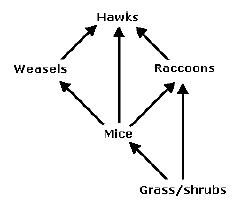 Which group of
organisms in this food web can be described as both primary and secondary
consumers? Which group of
organisms in this food web can be described as both primary and secondary
consumers?
a. | hawks | b. | raccoons | c. | weasels | d. | mice |
|
|
|
2.
|
According to the theory of natural selection, which
of the following organisms is most likely to survive in the given
environments?
a. | a large, leafy plant with shallow roots in a hot and dry
desert biome | b. | a bird with a short
beak in an area where insects live deep within the ground | c. | a rabbit with short, brown fur in a cold, snowy, arctic
environment | d. | a lizard that
exhibits the same coloration as its surrounding plant life |
|
|
|
3.
|
In order for nerve cells and muscle cells to
function properly, they require a high concentration of potassium ions
inside the cells and a high
concentration of sodium ions outside the cells.
To maintain this condition, cells utilize
sodiumpotassium pumps embedded within their cellular membranes to move the ions against their
concentration gradients.
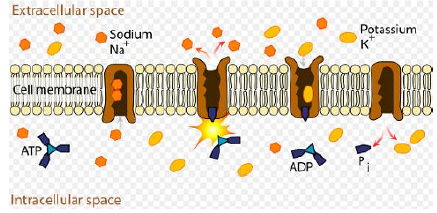 Since sodiumpotassium
pumps require an input of energy to operate, they are an example of... Since sodiumpotassium
pumps require an input of energy to operate, they are an example of...
a. | facilitated diffusion. | b. | passive transport. | c. | active
transport. | d. | filtration. |
|
|
|
4.
|
If a cat has 38 chromosomes in each of its body
cells, how many chromosomes will be in each daughter cell after
mitosis?
|
|
|
5.
|
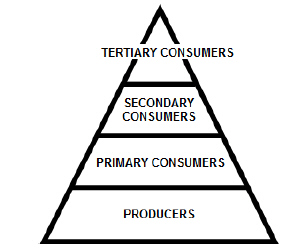 The above diagram suggests that The above diagram suggests that
a. | energy flows from secondary consumers to primary
consumers in an ecosystem. | b. | producers are the
foundation of all energy pyramids. | c. | tertiary consumers
are the ultimate source of energy in an ecosystem. | d. | there are more tertiary consumers than producers in an energy
pyramid. |
|
|
|
6.
|
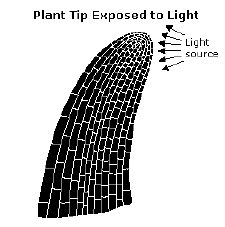 An experiment was set up to test the effects of light on the growing tip of a
plant. The diagram shows a longitudinal section of the growing plant tip. Which of these observations
correctly describes the results? An experiment was set up to test the effects of light on the growing tip of a
plant. The diagram shows a longitudinal section of the growing plant tip. Which of these observations
correctly describes the results?
a. | The walls of the cells farther away from the light source
are thicker. | b. | The cells in the
center of the plant are more flexible than cells on the sides. | c. | There are more cells on the side of the plants facing away from the light
source. | d. | The cells farther away from the light source are longer
than the cells facing the light. |
|
|
|
7.
|
Most organisms can be divided into two
categories prokaryotes
and eukaryotes. What is the main difference between these two
categories?
a. | Eukaryotes are found in all of the six major taxonomic
kingdoms. | b. | Prokaryotes do not possess a nucleus or any other
membrane bound organelles. | c. | Eukaryotes are
living organisms whereas prokaryotes include some nonliving matter. | d. | Prokaryotes do not possess any means of locomotion and are thus unable to
move. |
|
|
|
8.
|
Composting
As part of a class
exercise on composting, two students constructed identical worm bins (containers), which they kept at
their homes. Red
worms were then added to the bins. Both students counted the number of red worms
in their bins on the first of the month. The results are
shown in the graph below.
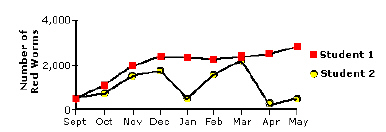 A worm bin should be kept between 12°C and 25 °C
and 2.5 kg of food should be added to a bin each week. Student 1 followed these A worm bin should be kept between 12°C and 25 °C
and 2.5 kg of food should be added to a bin each week. Student 1 followed these
requirements
exactly. During December, Student 2 left town for three weeks ; during March, the temperature in
Student 2’s worm bin reached
30°C.
Which of
the following probably accounted for the large drop in population in Student 2's bin from March
to April?
a. | overheating | b. | overpopulation | c. | lack of
food | d. | lack of water |
|
|
|
9.
|
Predators and their prey often evolve in response to
one another. This is called an evolutionary arms race.
For example, many mollusk species have
developed thick shells to avoid being eaten by crabs and fish. In response, crabs and fish have
developed powerful jaws and claws that can break through the thick shells. As time passes, the
mollusks will develop even thicker shells to compensate for the powerful jaws and claws.
A
change in the genetic traits of one species in response to a genetic change in another species is
known as _______.
a. | co-evolution | b. | commensalism | c. | mutualism | d. | parasitism |
|
|
|
10.
|
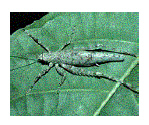
Because of this animal's
adaptations, it would be most successful at
a. | competing with birds. | b. | hiding from predators. | c. | running very
rapidly. | d. | making its own
food. |
|
|
|
11.
|
The cell membrane serves many functions. One of the
cell membrane's functions is to help the cell maintain
homeostasis. Which of the following
statements best supports this claim?
a. | The cell membrane contains a polar region and a nonpolar
region. | b. | The cell membrane regulates what goes in and out of the
cell. | c. | The cell membrane contains
phospholipids. | d. | The cell membrane
contains proteins. |
|
|
|
12.
|
Which of the following forms of RNA is transcribed
from DNA and carries coding information to the ribosomes?
a. | RNA polymerase | b. | mRNA | c. | tRNA | d. | rRNA |
|
|
|
13.
|
Alexis's school class will be traveling to the
city library next week to collect information on specific topics that
each student has chosen to
learn about. Alexis wants to learn about the cheetah, but she still needs to choose a
hypothesis
for her research. Which of these would work as a hypothesis for Alexis?
a. | The cheetah can run faster than the tiger but not as fast
as the jaguar. | b. | Is the cheetah the
fastest land mammal? | c. | What makes a
cheetah run fast? | d. | The cheetah runs
fast only when it is frightened. |
|
|
|
14.
|
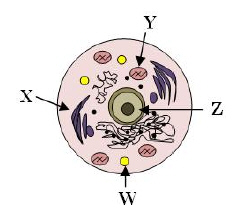
In the above animal cell, what
is the function of the cellular organelle labeled with the letter W?
a. | packages and distributes proteins and
lipids | b. | digests cellular wastes | c. | contains the cellular DNA | d. | provides the cell
with energy |
|
|
|
15.
|
Mitosis is the process through which a cell
replicates its DNA and produces two identical daughter cells. If a cell
undergoing mitosis is
currently in prophase as shown in the diagram below,


which of the following phases immediately follows?
|
|
|
16.
|

It was hypothesized that
there was a maximum number of red worms that could survive in the worm bins.
Is this hypothesis
supported by the data in the graph?
a. | Yes, because the number of red worms in Student 2's
bin continued to increase between September and
May. | b. | No, because the number of red worms in Student 2's bin decreased between
December and January. | c. | Yes, because the
number of red worms in Student 1's bin remained fairly constant between December
and
May. | d. | No, because the
number of red worms in Student 1's bin decreased between December and
May. |
|
|
|
17.
|
Suppose several house flies were allowed to enter
the worm bins and feed on the food scraps. Which of the
following interactions would most likely
occur between the house flies and the red worms?
a. | predation | b. | parasitism | c. | competition | d. | commensalism |
|
|
|
18.
|
Jennifer wants to breed finches. Her first finch has
a heavy beak and dark feathers, but she does not know its
genotype.
If beak type and feather
color are determined by two separate genes, and if a heavy beak (B) and dark feathers (F)
are
dominant over a light beak (b) and white feathers (f), then what finch genotype should Jennifer cross
her finch
with to learn the most information about her finch's genotype in one generation of
offspring?
|
|
|
19.
|
Which of the following best describes the way that
genes, chromosomes, and DNA are related?
a. | Genes contain several chromosomes, which are made up of
sequences of DNA. | b. | Sequences of DNA
contain several genes, which are made up of chromosomes. | c. | Genes contain several sequences of DNA, which are made up of
chromosomes. | d. | Chromosomes contain
several genes, which are made up of sequences of DNA. |
|
|
|
20.
|
As different organisms evolved from a common
ancestor, some of their body structures retained similarities even
if their functions deviated.
These structures are known as homologous structures.
Which of the following pairs of structures
are an example of homologous structures?
a. | tortoise shells and rhinoceros
horns | b. | mice whiskers and horse manes | c. | bat wings and human arms | d. | insect exoskeletons
and mammalian vertebra |
|
|
|
21.
|
Ten different types of culture media were inoculated
with the same strain of bacteria and incubated at the same
temperature. Nine of the cultures grew.
Which of these conclusions can be drawn from this information?
a. | The temperature varied greatly during the
experiment. | b. | One of the media
lacked the nutrients needed for the bacteria to grow. | c. | The media used in the experiment are all capable of sustaining bacterial
growth. | d. | Only the culture that failed to grow bacteria was
inoculated properly. |
|
|
|
22.
|
Cyanobacteria, or bluegreen algae, are
photosynthetic bacteria that live in both aquatic and land environments.
Given this description,
into which of the following categories should cyanobacteria be classified?
a. | consumer | b. | decomposer | c. | producer | d. | all of
these |
|
|
|
23.
|
Look at the DNA segment
below.
GATCGT
Which of the segments below would be complementary to the segment above
during DNA replication?
a. | CATGCT | b. | GTACGA | c. | CTAGCA | d. | CUAGCA |
|
|
|
24.
|
The Earth's carbon cycle consists of the flow,
cycling, and recycling of all of the carbon on the Earth. Every living
organism's composition
includes the element carbon. How does carbon become part of living organisms?
a. | Carbon is a part of sunlight and enters through the skins
of all organisms. | b. | Producers take in
carbon directly from the soil through their roots, and consumers eat the
producers. | c. | Consumers take in
carbon dioxide from the air, and producers eat the consumers. | d. | Producers take in carbon dioxide from the air, and consumers eat the
producers. |
|
|
|
25.
|
Many natural ecosystems have been destroyed by human
activity. To better manage our remaining natural
ecosystems, we must first understand how the
ecosystems are structured. One way to do this is to determine how the organisms in the ecosystem
obtain the matter and energy they need to survive. The figure below shows a simplified food
web.
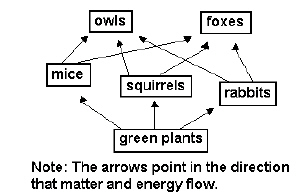
Often, organisms
compete with each other for a food source. Which of the following pairs of organisms compete with
each other for food?
a. | rabbits and green plants | b. | squirrels and owls | c. | mice and
owls | d. | mice and rabbits |
|
|
|
26.
|
Which of the following pieces of equipment would be
most appropriate for measuring the volume of a marble?
a. | a beaker | b. | a digital scale | c. | a graduated
cylinder | d. | a ruler |
|
|
|
27.
|
Which of the following scenarios is an example of
selective breeding?
a. | Longnecked giraffes thrive in an area with very tall
trees while giraffes with shorter necks struggle in the
same region. | b. | When a population of white moths migrates into an area of trees with dark bark,
they are eaten by
predators and become extinct. | c. | The dominant rooster on a farm contiuously fights with other roosters thereby
preventing them from
mating with hens in his flock. | d. | Two purebred black Labrador Retrievers are permitted to mate to produce a
litter of show quality black lab puppies. |
|
|
|
28.
|
Why does an enzyme function as a catalyst in a
reaction?
a. | It maintains the proper temperature needed for the
reaction. | b. | It provides the extra energy needed for the
reaction. | c. | It creates the right pH needed for the
reaction. | d. | It decreases the amount of energy needed for the
reaction. |
|
|
|
29.
|
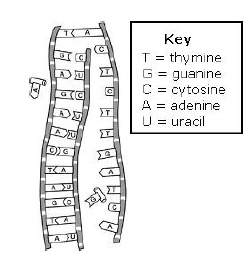 Which statement describes the diagram above? Which statement describes the diagram above?
a. | DNA transcription is producing messenger
RNA. | b. | DNA translation is producing ribosomal
RNA.. | c. | DNA transcription is producing ribosomal
RNA. | d. | DNA translation is producing messenger
RNA. |
|
|
|
30.
|
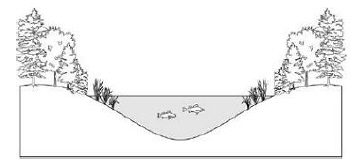 Which statement
describes how this ecosystem is likely to change after many years of succession? Which statement
describes how this ecosystem is likely to change after many years of succession?
a. | The number of plants will
increase | b. | The number of fish will
increase | c. | The elevation of the hill will
increase | d. | The level of the water will
increase |
|
|
|
31.
|
Daniel wants to know how much water is best to give
a pepper plant. He plans to buy 5 similar pepper plants in
pots and put them all in the same area
of his patio, in the sunshine. He will number each pot, 15,
and water them according to their
number:
Pot #1 he will water every day, pot #2 he will water every second day, pot #3 he will
water every third day, and so on. He will record his observations once each week. After 6 weeks, he
plans to evaluate the health of each plant,
recording his results.
What is the variable in
Daniel's planned experiment?
a. | where the plants will be
located | b. | the number that will be put on the
pots | c. | how frequently the plants will be
watered | d. | the initial size of the
plants |
|
|
|
32.
|
The carrying capacity for a population within an
ecosystem describes the number of organisms that can be
supported by the resources available
within that ecosystem over a period of time. Which event might increase the
carrying capacity for
rabbits in a prairie ecosystem?
a. | a decrease in vegetation | b. | a season of extra rain | c. | a new predator
species moving in | d. | a period of
drought |
|
|
|
33.
|
Which of these names the cellular process that
begins with the breakdown of organic compounds (such as
glucose) and continues with turning the
resulting pyruvic acid into a waste product and two molecules of ATP?
a. | photosynthesis | b. | cellular respiration | c. | fermentation | d. | chemosynthesis |
|
|
|
34.
|
Bunsen burners are often used in science labs as a
source of heat. Which of the following safety rules apply when
using Bunsen burners in the
lab?
a. | Tie back long hair and roll up loose
clothing. | b. | Never leave the bunsen burner
unattended. | c. | Always point the
opening away from yourself (and others) when heating a test tube. | d. | all of these |
|
|
|
35.
|
Energy conversion within an animal cell would be
severely limited by removal of the cell's
a. | Lysosomes. | b. | plastids | c. | mitochondria | d. | chloroplasts |
|
|
|
36.
|
Which cell organelle stores water and other
materials?
a. | Lysosome | b. | mitochondrion | c. | Golgi
complex | d. | vacuole |
|
|
|
37.
|
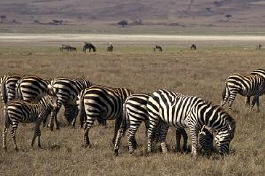
A herd of zebra eating
grass includes groups of organisms from different species. These groups best
exemplify
a. | a biome interaction | b. | a community interaction. | c. | an ecosystem
interaction. | d. | a population
interaction. |
|
|
|
38.
|
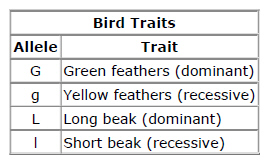
Consider the following
cross between two birds: GGLl (male) x Ggll (female)
What trait will most likely be observed in
all offspring of the above set of parents?
a. | Yellow feathers | b. | Long beak | c. | Short
beak | d. | Green feathers |
|
|
|
39.
|
Which of the following can cause a genetic mutation
in an organism's DNA?
a. | exposure to toxic chemicals | b. | insertion of a nucleotide during replication | c. | exposure to high energy radiation | d. | all of these |
|
|
|
40.
|
Which of the following measurement tools is used to
measure mass?
a. | graduated cylinder | b. | thermometer | c. | balance | d. | meter
stick |
|
|
|
41.
|
Many natural ecosystems have been destroyed by human
activity. To better manage our remaining natural
ecosystems, we must first understand how the
ecosystems are structured. One way to do this is to determine how the organisms in the ecosystem
obtain the matter and energy they need to survive. The figure below shows a simplified food web. Use
the figure to answer the following questions.
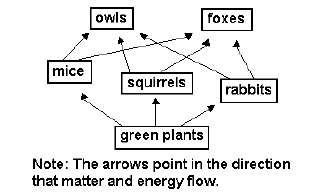 Based on the figure, how would the owls most likely respond if the mice all
died out? Based on the figure, how would the owls most likely respond if the mice all
died out?
a. | The owls would start eating
foxes. | b. | The owls would eat more green
plants. | c. | The owls would starve. | d. | The owls would eat more squirrels and
rabbits |
|
|
|
42.
|
When a sea urchin egg is removed from the ocean and
placed in freshwater, the egg swells and bursts. Which of
these causes water to enter the
egg?
a. | active transport | b. | sodium pump | c. | osmosis | d. | coagulation |
|
|
|
43.
|
What is the advantage of sexual reproduction over
asexual reproduction in organisms?
a. | more variety of reproduction
methods | b. | fewer parent organisms needed | c. | greater genetic diversity | d. | shorter
reproduction time |
|
|
|
44.
|
Examine the population growth curve shown
below.
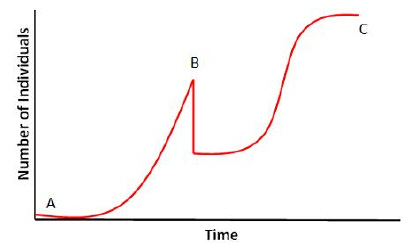 Which of the
following most likely caused the sharp decline in population at point B? Which of the
following most likely caused the sharp decline in population at point B?
a. | a shortage of food | b. | emigration of a competing species | c. | overpopulation | d. | disease |
|
|
|
45.
|
Many natural ecosystems have been destroyed by human
activity. To better manage our remaining natural
ecosystems, we must first understand how the
ecosystems are structured. One way to do this is to determine how the organisms in the ecosystem
obtain the matter and energy they need to survive. The figure below shows a simplified food web. Use
the figure to answer the following questions.
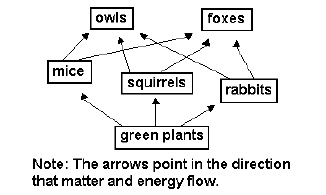 Which of the following correctly shows one pathway for the flow of energy to an
owl? Which of the following correctly shows one pathway for the flow of energy to an
owl?
a. | green plants ¨ mice ¨
squirrels | b. | owls ¨ green plants ¨
mice | c. | green plants ¨ squirrels ¨
owls | d. | owls ¨ squirrels ¨
foxes |
|
|
|
46.
|
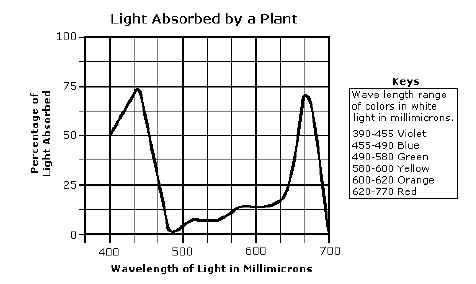 The most light absorbed by this plant is The most light absorbed by this plant isa. | blue and green | b. | violet and red | c. | green and
yellow | d. | blue and red |
|
|
|
47.
|
Plants-----> Aphids------> Spiders------>
Sparrows
In this food chain, the spiders
are
a. | competitors | b. | producers. | c. | secondary
consumers. | d. | primary
consumers. |
|
|
|
48.
|
Which of the following is true about DNA and
RNA?
I. DNA is a nucleic acid, whereas RNA is a protein.
II. DNA stores genetic
information, whereas RNA is directly involved in protein production.
III. Both DNA and RNA always
contain the nitrogenous base thymine.
IV. DNA contains the sugar deoxyribose, whereas RNA contains
the sugar ribose.
a. | I, II and IV only | b. | II and IV only | c. | I, II,III and IV
only | d. | III only |
|
|
|
49.
|
When a person inhales, oxygen fills tiny air sacs in
the person's lungs. Next, the oxygen moves from these air
sacs into small blood vessels that
line the lungs, and then it moves into the bloodstream so that it can be transported around the
body.
Oxygen moves by random molecular motion from the air sacs of the lungs to the blood
vessels because the
concentration of oxygen in the air sacs is higher than the concentration of
oxygen in the blood vessels.
This movement of oxygen molecules from an area of higher
concentration to an area of lower concentration is known as _______.
a. | photosynthesis | b. | diffusion | c. | respiration | d. | osmosis |
|
|
|
50.
|
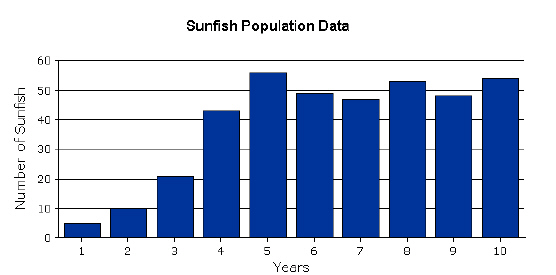
A sunfish population was
introduced into a lake 10 years ago. Since then, biologists have been monitoring this
population.
The graph shows their data. What is the estimated carrying capacity for sunfish in this
lake?
a. | 30 sunfish | b. | 40 sunfish | c. | 60
sunfish | d. | 50 sunfish |
|
|
|
51.
|
In a certain breed of cats, having black hair is the
result of two dominant alleles for hair color (HH). The
heterozygous genotype (Hh) produces a cat
that has black and white spots. Having two recessive (hh) genes results in a white haired cat. The
Punnett square below shows the results of a cross between which two cats?

a. | a spotted cat and a white cat | b. | a black cat and a spotted cat | c. | two black cats | d. | two spotted
cats |
|
|
|
52.
|
Many natural ecosystems have been destroyed by human
activity. To better manage our remaining natural
ecosystems, we must first understand how the
ecosystems are structured. One way to do this is to determine how the organisms in the ecosystem
obtain the matter and energy they need to survive. The figure below shows a simplified food web. Use
the figure to answer the following questions.
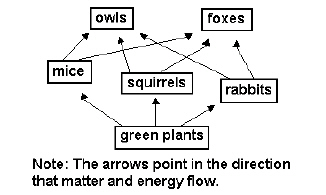 Based on the figure above, you would hypothesize that the green plants, unlike
animals, can do which of the Based on the figure above, you would hypothesize that the green plants, unlike
animals, can do which of the
following?
a. | release the energy stored in their
food. | b. | get energy from the other
organisms. | c. | avoid being eaten
by other organisms. | d. | make their own
food. |
|
|
|
53.
|
Which of the following is primarily responsible for
the coding of the amino acids used in the synthesis of cellular
proteins?
a. | transfer RNA | b. | ribosomes | c. | DNA | d. | Golgi
apparatus |
|
|
|
54.
|
Genetically modified organisms (GMOs) have included
corn crops engineered to produce a natural pesticide to kill
a certain insect which would normally
destroy the corn. The benefits include a larger corn crop, because the
destructive influence of
the insects is lowered. What might be one negative result of growing this specific
GMO?
a. | The geneticallymodified corn would require more water to
produce enough pesticide to fend off the
insects. | b. | The natural pesticide could get into the soil and kill the next corn
crop. | c. | All of the insects could disappear, allowing the corn
crop to grow too large. | d. | The insects could
grow resistant to the pesticide in the geneticallymodified
corn and become immune to regular
pesticides. |
|
|
|
55.
|
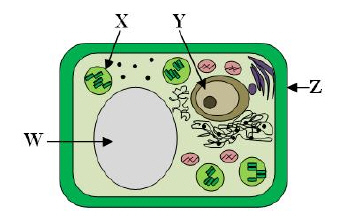
In the above plant cell,
what is the name of the cellular organelle labeled with the letter X?
a. | chloroplast | b. | cell wall | c. | nucleous | d. | vacuole |
|
|
|
56.
|
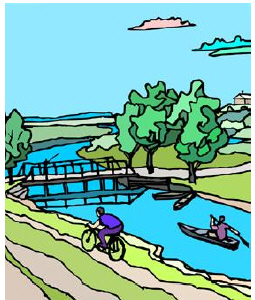
Which of the following is
an abiotic factor shown in the picture above?
a. | cloud | b. | grass | c. | person | d. | tree |
|
|
|
57.
|
Clown fish are small reef fish that seek protection
from predators by sheltering themselves among the stinging
tentacles of sea anemones. Clown fish
are very territorial and can potentially scare off predators of sea anemones.
This relationship is
an example of
a. | commensalism. | b. | parasitism. | c. |
mutualism | d. | neutralism. |
|
|
|
58.
|
Starfish are marine animals that live in saltwater
or ocean environments. Starfish are predators and often hunt for
shelled animals, such as oysters,
clams, or mollusks.
Fisherman who also hunt for shelled animals find starfish to be a nuisance
because they are competing for the same
prey. So, anytime a fisherman pulls a starfish up in his
net, he often cuts it into several pieces before returning it to
the ocean. Unfortunately for the
fishermen, however, this only causes the starfish population to
increase.
Why?
a. | Starfish can reproduce asexually, and the fragments
undergo meiosis. | b. | Starfish can
reproduce sexually, and the fragments undergo binary fission. | c. | Starfish can reproduce sexually, and the fragments mate with each
other. | d. | Starfish can reproduce asexually, and each fragment grows
into a new starfish. |
|
|
|
59.
|
In Central America there is a tree called bullhorn
acacia (Acacia cornigera) that provides both food and shelter to
a certain species of ant
(Pseudomyrmex ferruginea). The ants live within the tree without causing it harm. In fact, the
ants protect the tree by vigorously attacking and stinging other animals that try to eat it.
This
relationship is an example of _______.
a. | predation | b. | commensalism | c. |
mutualism | d. | parasitism |
|
|
|
60.
|
Robert Koch
In the nineteenth century Robert Koch
scientifically investigated the transmission of diseases. He proposed a
procedure that would
enable a person to determine if a specific microorganism caused a given disease. The first four steps
of this procedure are listed below:
1. Microbes must be isolated from an infected host
organism.
2. The isolated microbes are then grown in a pure culture.
3. The microbes from the
pure culture are injected into a new host.
4. If the new host contracts the disease, the microbes
must be isolated from the new host and grown in a new
culture.
What final step should be
taken to prove that these specific microbes cause the given disease?
a. | Inject diseased organisms with the microbes from the new
culture. | b. | Inject an organism immune to the disease with microbes
from the new culture. | c. | Compare the
original microbes with the microbes in the new culture. | d. | Mix the microbes from the new and old
cultures. |
|
|
|
61.
|
Which of these processes produces the most
ATP?
a. | photosynthesis | b. | anaerobic respiration | c. | All of these
produce the same amount of ATP. | d. | aerobic
respiration |
|
|
|
62.
|
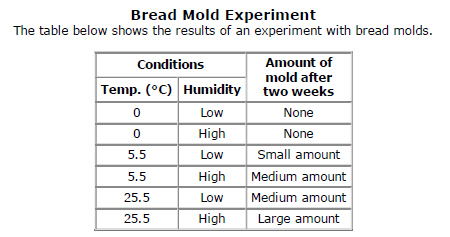 According to the data, what are the best conditions for growing
mold? According to the data, what are the best conditions for growing
mold?
a. | warm temperature and high
humidity | b. | cold temperature and high
humidity | c. | warm temperature and low
humidity | d. | cold temperature and low
humidity |
|
|
|
63.
|
 Sandra examined some
animal cells using a compound microscope. Under normal conditions, the cells have an Sandra examined some
animal cells using a compound microscope. Under normal conditions, the cells have an
approximate
salinity of 1 M NaCl and resemble the slide shown in picture 1.
If the cells are submerged in a
0.8 M NaCl solution, what will happen to the cells?
a. | Water will move into the cells until they swell and burst
as in picture 4. | b. | Nothing will happen
; they will look the same as in picture 1. | c. | Water will move
into the cells and they will swell as in picture 2. | d. | Water will move out of the cells and they will shrink as in picture
3. |
|
|
|
64.
|
The processes of photosynthesis and cellular
respiration form a continuous cycle.
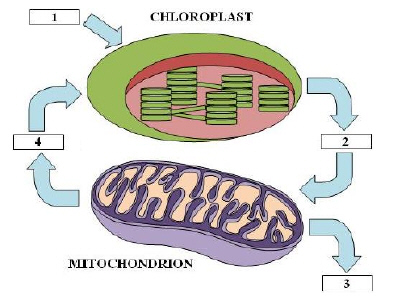
During this cycle, the products
from one process serve as the starting materials for the other. Which of the following materials
correspond(s) to box number 4?
a. | oxygen and glucose | b. | carbon dioxide and water | c. | ATP (energy) and
heat | d. | sunlight |
|
|
|
65.
|
James is homozygous dominant for curly hair (CC),
and his wife is heterozygous (Cc). What is the probability that their first child will also be
homozygous dominant for curly hair?
|